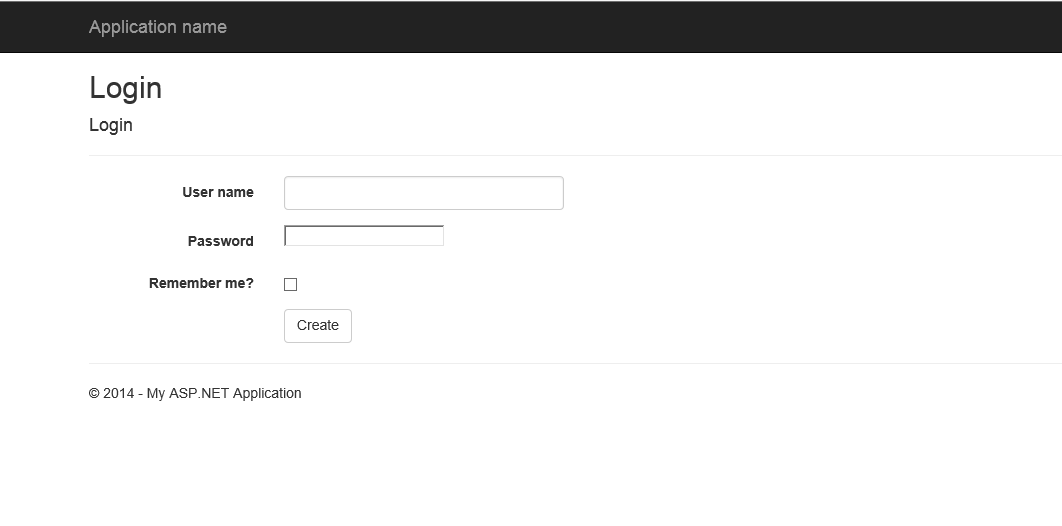AngularJS is a JavaScript frame work which use to create dynamic web applications. Its runs with plain JavaScript and HTML, so you don’t need use any other things when you are creating a web applications. You can read and learn more about the AngularJs from this link. In this post going to explain about the steps needs to follow when creating a SPA (Single Page Application) with AngualrJS.
Open your visual studio and create an empty web application. Install AngularJS core and router files using NuGet. After that create a folder called “app”. In this folder going to hold the old AngularJS related scripts files. Inside of this folder create a file calle “app.js”. In this JavaScript file is going to initialize all configurations when angular start up. Folder structure would be like as shown in below.
app
---------controller
--------------main.js
--------------submain.js
---------app.js
views
---------main
------------main.html
index.html
inside app folder contain the controller folder. It hold two angular controllers such as main and submain. And there is views folder for keep all the views. There is another subfolder call “main” to hold the views belongs to main controller. Index view is the initial view start in the application. In app.js file place the following code snippets.
var app = angular.module('spaapp', ['spaapp.controllers', 'ngRoute']);
var appctrl = angular.module('spaapp.controllers', []);
app.config(['$routeProvider', '$locationProvider', function ($routeProvider, $locationProvider) {
$routeProvider
.when("/",
{
templateUrl: "views/main/main.html",
controller: "main"
})
.when("/sub",
{
templateUrl: "views/main/submain.html",
controller: "submain"
})
.otherwise({
redirectTo: '/'
});
$locationProvider.html5Mode(true);
}]);
In here main module create as “spaapp”. Its getting inject with “ngRoute” and “spaapp.controllers”. The “ngRoute” use for client side routing inside the application and “spaapp.controllers” use as module of the controllers in the application. after that shows routing configuration of the application. When user navigate to root url, route configuration load the main controller with main.html view. As the same way it does for the “/sub” path.
So lets create content of the index.html view.
<!DOCTYPE html>
<html xmlns="http://www.w3.org/1999/xhtml">
<head>
<title></title>
<base href="/" />
</head>
<body ng-app="spaapp">
<ng-view></ng-view>
<script src="Scripts/angular.min.js"></script>
<script src="Scripts/angular-route.min.js"></script>
<script src="app/app.js"></script>
<script src="app/controller/main.js"></script>
<script src="app/controller/submain.js"></script>
</body>
</html>
Now what we left to do is creation of the main and submain controllers.
main controller
appctrl.controller('main', ['$scope', function ($scope) {
$scope.message = 'main';
}]);In main controller use the controller module created earlier in app.js file. This controller inject with $scope for handle the model. In this controller bind message to the $scope property called “message”. Following shows the main.html view for the above controller. This view contain route for the sub controller.
main.html view
<p>The controller name is {{message}}!</p>
<a href="/sub"> Sub Controller </a>submain controller
appctrl.controller('submain', ['$scope', function ($scope) {
$scope.message = 'sub main';
}]);
The submain controller is doing same thing as the main controller. In below showing a submain.html view. This view also same likes the main.html view. It has a link to navigate to the main view.
sub main view
<p>The controller name is {{message}}!</p>
<a href="/"> Back to Main Controller </a>
In this SPA, we load to views dynamically to the index.html. This magic happens through “<ng-view>” tag in the index.html. main and submain views get append to the “<ng-view>” tag when it called through the router. Route configuration handle the controller and view according to the route. Now run the application.
Main View
![1_thumb[3] 1_thumb[3]](https://lh3.googleusercontent.com/-TvoKgpKARmI/VpKK-HCHgNI/AAAAAAAAArs/d091R1a5b54/1_thumb%25255B3%25255D_thumb%25255B2%25255D.png?imgmax=800)
Sub Main View, you can see url of the browser.
![2_thumb[1] 2_thumb[1]](https://lh3.googleusercontent.com/--AwPoWqC5Ag/VpKLAwPG1XI/AAAAAAAAAr8/S5AHH0jp2TM/2_thumb%25255B1%25255D_thumb%25255B2%25255D.png?imgmax=800)
So we created SPA using an AngularJs. Give a try on this.
Happy Coding ![wlEmoticon-smile[2] wlEmoticon-smile[2]](https://lh3.googleusercontent.com/-jNo_clw5baQ/VpKKR1clq1I/AAAAAAAAArY/bzv9Pset-8g/wlEmoticon-smile%25255B2%25255D_thumb.png?imgmax=800)










![1_thumb[3] 1_thumb[3]](https://lh3.googleusercontent.com/-TvoKgpKARmI/VpKK-HCHgNI/AAAAAAAAArs/d091R1a5b54/1_thumb%25255B3%25255D_thumb%25255B2%25255D.png?imgmax=800)
![2_thumb[1] 2_thumb[1]](https://lh3.googleusercontent.com/--AwPoWqC5Ag/VpKLAwPG1XI/AAAAAAAAAr8/S5AHH0jp2TM/2_thumb%25255B1%25255D_thumb%25255B2%25255D.png?imgmax=800)


